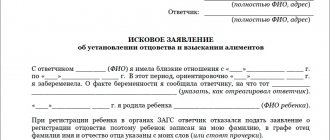A child has the right to financial support, regardless of whether the marriage between the parents is registered.
The Family Code of the Russian Federation obliges parents to financially support their children. If the parents refuse, the issue of payments is decided by the judge when considering the case. In order to receive alimony, you need to file a lawsuit or an application for a court order.
The question of how to apply for alimony if we are not married, but the child is registered with the father, is resolved in a general manner. Registration of marriage does not matter if the father recognizes the children.
If the father is not identified, a genetic examination is carried out to establish paternity.
After receiving the expert opinion, the judge determines the amount of payments. The father will have to share 0.25 percent of his earnings with one child, 33 percent of the salary for two children, and three children have the right to half of the father’s income.
The parties can negotiate the terms and conditions of payment between themselves. Conclude an agreement. Establish responsibility for late payments.
How can I apply for child support if my father and I do not live in an official marriage?
If the child is registered with the father and there is no doubt about his paternity, then you can apply for alimony in one of two ways: with the voluntary consent of the father or forcibly, in court.
If there are no disagreements between the mother and father of the child regarding the calculation of alimony, then you can follow the path of least resistance and draw up a voluntary alimony agreement. The mother and the registered father of the child just need to draw up an agreement and have it certified by a notary. This agreement takes into account issues such as the amount of alimony payments, the form of payments and the frequency of alimony. In addition, it is possible to establish a certain period and payments in kind (specific groups of goods, a one-time payment in the form of the transfer of certain property of the payer, or in another form convenient for both parties). However, such payments should not violate the rights of the child.
Alimony when establishing paternity
So, paternity has been established. If the mother and child live separately from the father, then in the future she has the opportunity to determine the procedure for the financial support of the child by his father. This order can be determined in two ways:
- voluntarily (parents enter into an agreement on the payment of child support);
- forcibly (by filing a claim for alimony).
Agreement
To draw up a voluntary child support agreement, the child’s parents contact a notary office. The text of the agreement consists of the following points:
- Type of deductions. It can be a percentage or a fixed amount of money.
- Periodicity. Parents can set monthly, quarterly or annual payments.
- Payment procedure. Cash, postal order, bank transfer, etc.
- The procedure for sanctions in case of violation of the terms of the agreement.
The document is certified by a notary and has the force of a writ of execution. If the terms of the agreement are violated, the mother has the right to transfer the document to the SSP.
Forcibly
If a parent who does not live with the child refuses to support him, or constantly postpones the conclusion of a voluntary agreement, the second one can apply to the court with a claim for the recovery of alimony.
A claim can be filed:
- mother, if the baby lives with her;
- father, if the child’s mother is deprived of parental rights;
- guardian if the child lives with him.
An application for the collection of alimony is submitted to the magistrate’s court at the child’s place of residence. The judge issues a court order and the writ of execution is sent to the bailiff service.
Joint application for collection of alimony and establishment of paternity
In accordance with Resolution of the Plenum of the Supreme Court No. 56 of 2021, when filing a claim to establish paternity, the applicant has the right to file an additional petition for the recovery of alimony.
Sample statement of claim to establish paternity and collect alimony
Please note: alimony in a joint claim to establish paternity and collect alimony is assigned only from the date on which the claim was filed. This is due to the fact that until a decision is made to establish paternity, the man has no legal relationship and, accordingly, alimony cannot be collected from him.
So, we have found out that a civil marriage cannot be the basis for the emergence of parental rights of the father in relation to the baby born in such a marriage. It is good if both parents have expressed a desire to formalize paternity. If one of them is against the procedure, then the procedure for establishing paternity may be delayed. That is why lawyers advise seeking help from a family law lawyer.
You can also contact the lawyers on our website. You can do this in two ways: call the indicated numbers, or write a message online.
FREE CONSULTATIONS are available for you! If you want to solve exactly your problem, then
:
- describe your situation to a lawyer in an online chat;
- write a question in the form below;
- call Moscow and Moscow region
- call St. Petersburg and region
Save or share the link on social networks
(
1 ratings, average: 5.00 out of 5)
- FREE for a lawyer!
Write your question, our lawyer will prepare an answer for FREE and call you back in 5 minutes.
By submitting data you agree to the Consent to PD processing, PD Processing Policy and User Agreement
Useful information on the topic
1
Application to establish the fact of recognition of paternity after the death of the father
If the child’s father died without having time or without wanting to admit...
How to establish paternity and collect child support
A woman who gave birth to a child outside of marriage, and upon receipt of a certificate...
How to establish paternity after the death of a father in court
Many married couples start a family without formalizing their relationship…
What documents are needed to establish paternity?
All over the world, married couples practice so-called civil marriages,…
Presumption of paternity
In the legislation of most countries, the term “presumption” is widely known...
1
Petition to order a genetic examination to establish paternity
A married couple lives in a civil marriage, a child is born, but the man...
What if the child's father and I are at odds?
In this case, the mother needs to go to court. Here, too, there may be two options for resolving the situation. The first option provides that the mother will apply to the court to issue a court order. There is no need to worry about the question “Do I have the right to apply for a restraining order if the child is not born out of wedlock?” There definitely is. However, the court will not accept the application if the paternity of the child is in question. In this document, you should briefly outline your requirements and justify them.
What documents are required from me when applying?
The court needs grounds for calculating the amount of alimony that will be withdrawn from the child’s father. Therefore, the application must be accompanied by confirmation of the child’s paternity, the child’s birth certificate and other documents confirming the identity of the parents. You should also be sure to indicate the father’s place of residence, place of work, or current location so that the court has the opportunity to send a copy of the court order to the second parent. An application can only be submitted in writing to the regional magistrate. If the information provided is sufficient, the judge approves the order and sends a copy to the father’s address. The latter has ten days to refute this document if he does not agree with its terms.
How to determine paternity
To determine the relationship between a man and a child, you can use several methods. But for each of them the degree of probability will be different.
These methods include:
- determination by external similarity,
- by estimated date of conception,
- by blood type,
- carrying out DNA testing.
When determining kinship, they turn to the help of geneticists, since the methods listed above are directly related to heredity.
If the baby inherited the external features of his mother, then it is simply unrealistic to determine his relationship with his father. Of course, if the child, as they say, is the spitting image of his father, then the debate is pointless.
When the presence of a relationship is determined by external similarity, the features of the child and the father are compared: the color and shape of the eyes, the shape of the nose and face, the presence of a dimple on the chin (this trait is inherited in 95% of cases), the shape of the hands and feet, gait, etc.
It is also impossible to determine relationship by blood group with 100% accuracy. Only the probability of relationship is determined. For example, the father has blood group I (0), the mother – II (A). Their children can only have their father's or mother's blood type.
By the way, there is a table that describes combinations of different blood groups. That is, a man with blood type 0 can be the child’s natural father, but if he has a different group, kinship is impossible.
A child born to parents with blood group I (0) or II (A) can only have this group. In addition, children with this group are also born from parents with other blood groups. Thus, determining kinship using this method does not provide any guarantee of obtaining an accurate result.
The method associated with establishing the probable date of conception also cannot be considered perfect. Yes, it is possible to find out the gestational age with an accuracy of 4-5 days, but only a woman can say which man got pregnant. Although if during the supposed period of conception she had different sexual partners, no one will know the truth. That is, you should not trust this method.
Note! The most reliable way to determine the father of a child can only be considered a DNA examination. It guarantees 99-100% results.
Alimony for a second child in a second marriage.
What documents are needed to apply for child benefits, read here.
What documents are needed to obtain alimony for a child without marriage, read the link: https://novocom.org/semya-i-deti/kakie-nuzhny-dokumenty-dlya-oformleniya-alimentov-na-rebenka-bez-braka.html
What if the application I submitted is not approved by the court or the order is denied by the child's father?
If the child is registered with the father, then you can safely file a lawsuit for child support. In this case, you will have to resort to court proceedings, during which you will confirm that the child is registered with the father, as a result of which he can qualify for alimony. Depending on the number of children born out of wedlock, as well as the social, financial and physical condition of the mother and child, the court will be able to calculate the amount of alimony.
Carrying out genetic testing
Genetic testing is one of the modern and most reliable ways to determine kinship. The research compares the biological materials of the alleged father and the child.
Specialists usually take:
- blood from a vein,
- hair,
- pieces of the nail plate,
- samples of the mucous membrane from the inside of the cheek.
The examination will take from 7 to 14 days. The accuracy of the result is almost absolute. Only special laboratories (with permission to perform such analyzes) are engaged in conducting research on biomaterials. Based on the results of the work done, they give an appropriate conclusion.
Important! Expert opinions are accepted as evidence during legal proceedings.
If I have a child with a disability, is he entitled to additional benefits?
If the child has a disability of 2-3 groups, the father will be obliged to pay alimony in a larger amount to cover the costs of additional medical care for the disabled person or providing him with the necessary medications. If the child has a disability of the 1st group or incapacity, then the payer is obliged to pay funds not only for the maintenance of the child, but also about 50% of the amount of alimony to his mother.
Can I count on alimony, being the mother of a child from a father with whom we were not married? How much do they pay me?
Regardless of whether the parents were ever married or not, alimony is also paid to the mother of a child under three years of age if she is on maternity leave. Naturally, this applies exclusively to alimony regarding the biological children of the alimony payer. However, if the child is incapacitated and the mother must sacrifice her employment to provide adequate care for the child, then child support may be paid for life for the mother or child if no additional income is received.
Options for establishing paternity
If the parents’ marriage is official, then the father’s information is recorded automatically; the man’s presence at the registry office is not even required. According to the law, the official husband of his mother is recognized as the blood father of a newborn. Also in the Russian Federation there is a presumption of paternity, according to which the mother’s ex-husband is recognized as the father if no more than 300 days have passed since the divorce or death of the spouse.
There are completely different conditions for recording data about the father if the parents live in a civil marriage. In this case, to enter information about the father, additional documents will be needed, namely:
- Joint statement by the baby's parents . It is necessary in cases where the common-law husband makes a voluntary decision to recognize paternity (Article 48 of the RF IC).
- A court decision establishing paternity that has entered into force . It is necessary in cases where the child’s father does not want to recognize the blood relationship between him and the baby (Article 49 of the RF IC).
- PLO permission and father's statement . It is necessary in cases where the mother cannot raise the baby (she died, was deprived of parental rights, went missing, etc.), and the father expressed a desire to establish a family relationship with him (Article 48 of the RF IC).
- A court decision to establish the fact of paternity has entered into force . It is necessary in cases where the child’s father did not live to see his birth, or died before he had time to formalize paternity (Article 50 of the RF IC).
Option 1. Joint application of both parents
The easiest way to formalize paternity is a joint application to establish paternity through the registry office. If the baby’s parents have expressed a joint desire to include information about the father in the baby’s birth certificate, then they will only need to visit the registry office together and write a joint application to include information about the father in the child’s birth certificate.
You can write a statement:
- Before the baby is born . It is practiced in cases where the mother’s common-law spouse is seriously ill and fears that he will not live to see his birth. Parents can also leave such a statement if the child’s father leaves for a long time and is unable to visit the registry office shortly after his birth.
- At the time of registration of the fact of birth . Both parents visit the registry office, write a joint statement, and information about both the mother and father of the child is entered into the birth certificate.
- After registering the birth . The common-law spouse can establish paternity at any time after the birth certificate is issued. To do this, he will also need to write a joint application, and the registry office employee will make the necessary changes to the birth record and the birth certificate of the minor.
Procedure
According to Art. 50 Federal Law No. 143-FZ of 1997, common-law spouses must:
- Prepare all necessary documents.
- Pay the state fee.
- Visit the registry office where you can write a joint application.
- Get the baby's birth certificate.
Required documents
When visiting the registry office, common-law spouses must have with them:
- passports;
- a certificate of birth of the baby from their medical institution (if paternity is registered at the time of registration of birth);
- child’s birth certificate (if paternity registration occurs after birth registration);
- receipt of payment of state duty;
- personal written consent of the child if he is 10 years old.
In 2021, the state duty is 350 rubles.
Option 2. Permission from the guardianship and trusteeship authorities
In cases where the child’s mother does not have the opportunity or right to submit a joint application with the child’s father, the father can submit an application to the registry office on his own. But this is possible only with the permission of the guardianship and trusteeship authorities of the district or city where the baby is registered.
Independent registration of paternity without permission for the procedure from the baby’s mother is possible if:
- she died;
- deprived of parental rights;
- declared missing by a court decision that has entered into force;
- unknown missing;
- declared incompetent by the court.
Procedure
In accordance with Art. 51 Federal Law No. 143-FZ of 1997, the child’s father must adhere to the following algorithm:
- Collect the necessary documents.
- Obtain permission to register paternity from the guardianship and trusteeship authorities.
- Pay the state fee.
- Visit the registry office, where you can write an application to register paternity.
- Get a new birth certificate for your baby.
List of documents
When visiting the registry office, a man must have the following package of documents with him:
- statement;
- passport;
- baby's birth certificate;
- receipt of payment of state duty;
- a document confirming that the child’s mother cannot submit a joint application.
Such a document could be:
- certificate or death certificate of the mother;
- a certificate from law enforcement agencies stating that she is wanted;
- a court decision that has entered into force that the baby’s mother is declared incompetent or missing;
- a court decision to deprive the mother of parental rights has entered into force.
Option 3. Through the court
If either parent does not agree to formalize paternity through the registry office, then the second has the right to make changes to the birth record based on a court decision. In this case, the initiator of the lawsuit must apply to the district or city court at the opponent’s place of residence.
Please note: if the plaintiff includes a petition for alimony in the statement of claim to establish paternity, then the claim can also be filed at the place of registration of the minor.
The applicant's algorithm of actions is as follows:
- Preparation of all necessary documents.
- Drawing up a statement of claim.
- Transfer of the claim along with a package of documents to the court office.
- Participation in court hearings.
- If necessary, conduct genetic testing.
- Receipt of a court decision that has entered into force.
- Change in the birth record of the baby in the registry office.
Preparation of evidence
According to the Resolution of the Plenum of the Supreme Court No. 15 of 2021, evidence of family ties in a trial to establish paternity can be:
- medical documents on pregnancy and childbirth;
- DNA testing results;
- witness statements;
- written evidence;
- audio, photo and video documents;
- bank statements;
- receipts for the purchase of children's goods;
- receipts for postal money transfers, etc.
Please note: the court considers all evidence in its entirety, even genetic testing. No piece of evidence is given priority over others.
Drawing up a statement of claim
The statement of claim to establish paternity must be drawn up in accordance with Art. 134 – 136 Code of Civil Procedure of the Russian Federation, otherwise it will be returned to the applicant.
The statement of claim must contain the following information:
- The name of the district (or city) court to which the claim is filed.
- Last names, first names and patronymics of the plaintiff and defendant, as well as their place of registration.
- The essence of the claim. Here the applicant must indicate exactly what claims he has against the defendant (the defendant refuses to recognize his child, or the mother refuses to recognize that I am the father).
- Grounds for filing a claim. Here the plaintiff must list the circumstances confirming the opponent’s violation of the applicant’s rights and name the facts proving his position.
- A numbered list of all documents attached to the statement of claim.
Important. When drawing up a statement of claim, the law allows for the statement of other demands, for example, a petition to order a genetic examination.
Sample statement of claim to establish paternity
Court hearing
The court will satisfy the applicant's claims in cases where:
- all evidence presented by the plaintiff indicates his paternity;
- the result of a genetic examination confirms the relationship between the father and the baby;
- the defendant refuses to conduct a DNA test without a valid reason (recognition of paternity by default);
- The defendant admits the relationship.
Until what age will a child receive child support from a father with whom we were never married?
As in other cases, the child has the right to receive alimony payments until he reaches the age of majority, without fail. After 18 years of age, alimony can also be issued, but it is only available to disabled children who do not receive additional income. However, the father can stop paying child support earlier, legally. This can happen if a child enters into a legal marriage before the age of eighteen or begins to engage in official business activities that bring him a stable income. In these cases, the state considers the child a fully capable citizen who can provide for himself independently.
What should I do if the child’s father refuses to pay me child support?
If alimony is assigned by the court or during the preparation of an alimony agreement, but the payer avoids making payments or pays alimony irregularly and not in full amounts, then the recipient has the right to withdraw from the debtor 0.5% of the penalty for each day of debt. The legislation provides for situations in which a father refuses to make alimony payments for the mother of his child, with whom the latter has never been officially married. In this case, you can safely issue a penalty.
Is it possible to punish a debtor when he refuses to pay?
You can punish. Bailiffs can prohibit the debtor from driving or prohibiting foreign travel. But what to do if you think that a man is not worthy of being a father? Deprive rights. This is difficult to do because evidence is needed.
Grounds for deprivation of rights:
- The debtor refuses to pay.
- Made delays in the transfer of funds systemic.
- Denies financial support to children for a long time.
- Treats the child poorly. A bad attitude does not mean that the son asks for a car, but the father refuses to buy it. We are talking about more serious things. The father instills bad tendencies in his son. Teaches you to steal or beg, drink alcohol or use drugs.
- A man beats children.











